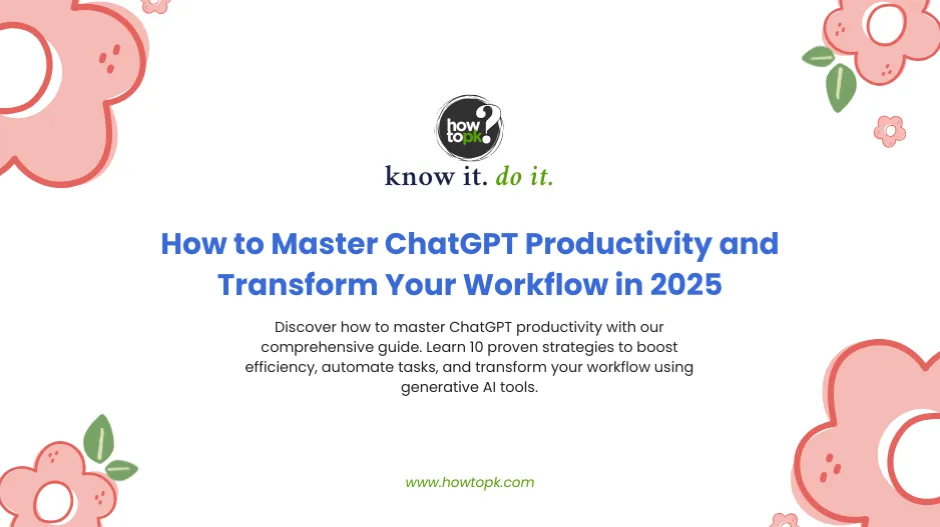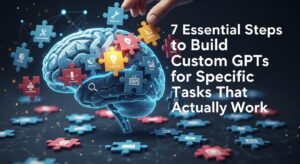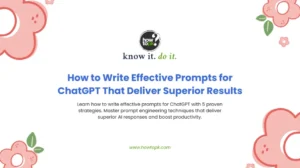ChatGPT productivity has become the ultimate game-changer for professionals seeking to revolutionize their work processes. As generative AI continues to reshape how we approach daily tasks, mastering these powerful tools isn’t just an advantage—it’s becoming essential for staying competitive in today’s fast-paced digital landscape.
Whether you’re a business owner, content creator, developer, or knowledge worker, understanding how to harness ChatGPT productivity techniques can dramatically reduce your workload while improving output quality. This comprehensive guide will walk you through 10 proven strategies that successful professionals use to maximize their efficiency with generative AI tools.
What Makes ChatGPT Productivity So Powerful?
Before diving into specific techniques, it’s crucial to understand why ChatGPT productivity methods are so effective. Unlike traditional software that requires extensive training, generative AI tools like ChatGPT can adapt to virtually any task through natural language communication.
The key advantages include:
- Instant expertise: Access specialized knowledge across multiple domains
- 24/7 availability: Work assistance whenever you need it
- Scalable output: Handle multiple tasks simultaneously
- Consistent quality: Maintain high standards across all outputs
- Learning acceleration: Rapidly acquire new skills and knowledge
Research from McKinsey & Company shows that generative AI could boost productivity by 0.1 to 0.6 percent annually through 2040, making it one of the most significant technological advances of our time.
1. Master the Art of Prompt Engineering for Maximum ChatGPT Productivity
The foundation of ChatGPT productivity lies in crafting effective prompts. Your ability to communicate clearly with AI directly impacts the quality and usefulness of responses.
Essential Prompt Engineering Techniques:
- Be Specific and Detailed Instead of asking “Help me write content,” try: “Create a 500-word blog post about sustainable marketing practices for small businesses, focusing on cost-effective strategies and including 3 actionable tips.”
- Use Context Setting Begin prompts with relevant background: “As an experienced marketing manager in the SaaS industry, I need help creating a customer retention strategy for our B2B platform…”
- Implement Role-Playing Assign ChatGPT specific roles: “Act as a senior data analyst and help me interpret these customer satisfaction survey results…”
- Structure Your Requests Use numbered lists, bullet points, and clear sections to organize complex requests.
2. Automate Repetitive Tasks to Boost AI Productivity
One of the most immediate ways to improve ChatGPT productivity is by identifying and automating repetitive tasks that consume your time daily.
High-Impact Automation Opportunities:
Task Category | Examples | Time Saved |
Content Creation | Blog outlines, social media posts, email templates | 60-80% |
Data Analysis | Report summaries, trend identification, insights generation | 50-70% |
Communication | Meeting agendas, follow-up emails, proposal drafts | 40-60% |
Research | Market analysis, competitor research, trend monitoring | 70-85% |
- Email Management Strategy: Create templates for common scenarios using ChatGPT. For instance, develop standardized responses for customer inquiries, meeting requests, and project updates. This approach can reduce email composition time by up to 75%.
- Content Calendar Automation: Generate months of content ideas, headlines, and outlines in a single session. This batch processing approach maximizes efficiency and ensures consistent output quality.
3. Leverage ChatGPT for Advanced Content Creation and Writing
ChatGPT productivity truly shines in content creation, where it can dramatically accelerate your writing process while maintaining high quality standards.
Strategic Content Development:
Multi-Stage Content Creation Process:
- Ideation Phase: Generate 20+ topic ideas in minutes
- Structure Development: Create detailed outlines with key points
- First Draft Generation: Produce initial content versions
- Refinement: Polish tone, style, and messaging
- Optimization: Enhance for SEO and readability
Content Repurposing Excellence: Transform single pieces of content into multiple formats:
- Convert blog posts into social media series
- Turn webinar scripts into email sequences
- Adapt whitepapers into video scripts
- Transform case studies into infographics
4. Optimize Business Processes with AI-Driven Workflows
Integrating ChatGPT productivity into your business processes requires strategic thinking about where AI can add the most value.
Process Optimization Framework:
- Audit Current Workflows Document existing processes and identify bottlenecks, repetitive tasks, and areas requiring specialized knowledge.
- Implement Gradual AI Integration Start with low-risk, high-impact areas before expanding to critical business functions.
- Measure and Iterate Track productivity gains and continuously refine your AI-enhanced workflows.
- Customer Service Enhancement: AI can transform customer interactions by providing instant support, generating personalized responses, and escalating complex issues appropriately.
5. Harness Data Analysis and Business Intelligence Capabilities
ChatGPT productivity extends beyond content creation into sophisticated data analysis and business intelligence applications.
Data-Driven Decision Making:
- Pattern Recognition: Upload datasets and ask ChatGPT to identify trends, anomalies, and correlations that might not be immediately obvious.
- Report Generation: Transform raw data into executive summaries, actionable insights, and presentation-ready visualizations.
- Predictive Analytics Support: Use AI to help interpret complex statistical models and forecast business outcomes.
- Market Research Acceleration: Analyze competitor data, industry trends, and customer feedback at scale.
6. Create Custom GPTs for Specialized Tasks
Building custom GPTs represents the next level of ChatGPT productivity, allowing you to create specialized AI assistants tailored to your specific needs.
Custom GPT Applications:
Industry-Specific Assistants:
- Legal document analysis tools
- Medical coding assistants
- Financial planning advisors
- Marketing campaign strategists
Process-Specific Solutions:
- Project management coordinators
- Quality assurance reviewers
- Customer onboarding specialists
- Technical documentation generators
Knowledge Management Systems: Create GPTs trained on your company’s specific knowledge base, policies, and procedures.
7. Integrate AI Tools into Your Development Workflow
For developers and technical professionals, ChatGPT productivity can revolutionize coding, debugging, and system design processes.
Development Acceleration Techniques:
Code Generation and Optimization:
- Generate boilerplate code and templates
- Optimize existing code for performance
- Create comprehensive documentation
- Design API endpoints and database schemas
Debugging and Troubleshooting:
- Analyze error messages and suggest solutions
- Review code for potential issues
- Generate test cases and validation scripts
- Explain complex algorithms and functions
Learning and Skill Development:
- Understand new programming languages
- Learn framework best practices
- Stay updated with technology trends
- Practice coding interview questions
8. Enhance Visual Content Creation with AI Image Generation
ChatGPT productivity extends into visual content through integration with AI image generation tools like DALL-E and Midjourney.
Visual Content Strategy:
- Marketing Materials: Create consistent brand visuals, social media graphics, and promotional content without extensive design skills.
- Presentation Enhancement: Generate custom illustrations, diagrams, and visual aids that perfectly match your content needs.
- Product Development: Visualize concepts, create prototypes, and explore design variations quickly and cost-effectively.
- Brand Consistency: Maintain visual coherence across all platforms and communications.
9. Implement Advanced AI Model Fine-Tuning
For organizations seeking maximum ChatGPT productivity, fine-tuning AI models for specific use cases represents the cutting edge of implementation.
Fine-Tuning Applications:
- Domain-Specific Performance: Optimize models for industry-specific language, terminology, and requirements.
- Quality Consistency: Ensure outputs consistently match your brand voice and quality standards.
- Efficiency Gains: Reduce the need for extensive prompting by training models on your preferred formats and styles.
- Competitive Advantages: Develop proprietary AI capabilities that differentiate your organization.
10. Maximize ROI with Strategic AI Email Marketing
Email marketing represents one of the highest-ROI applications of ChatGPT productivity, enabling personalized communication at scale.
Email Marketing Transformation:
- Personalization at Scale: Generate individually tailored email content based on customer behavior, preferences, and purchase history.
- A/B Testing Optimization: Create multiple email variations to test subject lines, content approaches, and call-to-action strategies.
- Customer Journey Automation: Develop sophisticated email sequences that guide prospects through your sales funnel.
- Performance Analysis: Analyze campaign results and generate insights for continuous improvement.
Essential Security Considerations for AI Productivity
As you implement ChatGPT productivity strategies, maintaining data security and privacy remains paramount.
Security Best Practices:
Data Protection Protocols:
- Avoid sharing sensitive company information
- Implement access controls and user permissions
- Regular security audits and compliance checks
- Employee training on AI security practices
Privacy Compliance:
- GDPR and CCPA considerations
- Customer data protection measures
- Audit trails and data governance
- Third-party vendor assessments
Measuring and Optimizing Your AI Productivity Gains
Successful ChatGPT productivity implementation requires systematic measurement and continuous optimization.
Key Performance Indicators (KPIs):
Metric Category | Specific Measurements | Target Improvement |
Time Efficiency | Task completion time, workflow speed | 40-70% reduction |
Quality Metrics | Error rates, revision cycles | 50-80% improvement |
Cost Savings | Labor costs, tool expenses | 30-60% reduction |
Output Volume | Content produced, tasks completed | 200-400% increase |
Continuous Improvement Framework:
- Baseline Measurement: Document current performance levels
- Implementation Tracking: Monitor changes during AI adoption
- Regular Assessment: Weekly and monthly performance reviews
- Strategy Refinement: Adjust approaches based on results
- Scaling Success: Expand successful implementations
Future Trends and Emerging Opportunities
The landscape of ChatGPT productivity continues evolving rapidly, with several exciting developments on the horizon:
- Multi-Modal AI Integration: Combining text, image, audio, and video processing for comprehensive workflow solutions.
- Real-Time Collaboration: AI assistants that actively participate in team meetings and collaborative work sessions.
- Predictive Workflow Optimization: Systems that anticipate your needs and proactively suggest productivity improvements.
- Industry-Specific AI Solutions: Highly specialized AI tools designed for specific sectors and professional roles.
Conclusion: Transform Your Productivity with Strategic AI Implementation
Mastering ChatGPT productivity isn’t just about using AI tools—it’s about strategically integrating these capabilities into your workflows to achieve transformational results. The professionals and organizations that thrive in the coming years will be those who embrace AI as a collaborative partner rather than a replacement.
Start with the fundamentals: perfect your prompt engineering skills, identify high-impact automation opportunities, and gradually expand your AI toolkit. Remember that sustainable productivity gains come from consistent application and continuous learning rather than sporadic experimentation.
The investment you make in mastering ChatGPT productivity today will compound over time, creating competitive advantages that become increasingly difficult for others to replicate. Whether you’re looking to streamline content creation, enhance customer service, or optimize business processes, the strategies outlined in this guide provide your roadmap to AI-powered success.











